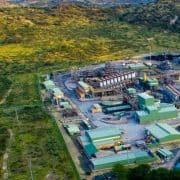|
Getting your Trinity Audio player ready...
|
Environmental oversight of mines should not be in the hands of department tasked with promoting the sector
Tracey Davies and Melissa Fourie
In three recent judgments, South Africa’s courts made adverse findings about actions taken by the Department of Mineral Resources and expressed concern about the competence of some of its most senior officials.
In November, the High Court in Pretoria found that mining company Aquila Steel had “established a high degree of institutional incompetence” on the part of the minister of mineral resources, the director-general of the Department of Mineral Resources, the deputy director-general: mineral regulation at the department and its Northern Cape regional manager and “a lack of energy in resolving the issues which arose from that very incompetence”.
Also in November, in the case of AngloGold Ashanti vs the Department of Mineral Resources, the Labour Court found that the department’s officials, including its acting chief inspector of mines, had been guilty of “reckless issuances of section 54 notices”, had ignored the notion of proportionality and had “acted outside the bounds of rationality” when applying mine health and safety legislation.
A COMPROMISED REGULATOR PROVIDES PERFECT CONDITIONS FOR THE FLOURISHING OF A PATRONAGE SYSTEM
The court also indicated that if the company had applied for an order awarding costs against the officials involved in their personal capacity, it would have seriously considered doing so.
And on March 20, in the case of Mineral Sands Resources vs Magistrate for the District of Vredendal and Others, the High Court in Cape Town found that the view of the department’s Western Cape regional manager that the mining company did not need environmental authorisations was “patently wrong”.
This “patently wrong” view, in effect, meant that the department allowed the mining company to get away with multiple unlawful activities.
Although mining companies are usually reluctant to speak publicly about this, off the record many express their frustration with the department’s poor and often unlawful decision-making and with the capriciousness of many of its officials.
Industry frustration is now spilling out into SA’s courts, and these judicial findings confirm many of the experiences of mining-affected communities and environmental justice activists over at least the past decade. The Department of Mineral Resources appears to be unable or unwilling to uphold its constitutional obligations.
The dysfunction within the department strikes a particularly discordant tone when it comes to its responsibility to monitor and enforce compliance with environmental laws by mining companies.
Until 2014, mines were regulated differently from all other industries, with a separate, weaker environmental legal regime in terms of the Mineral and Petroleum Resources Development Act. In 2014, the so-called “one environmental system” came into effect, requiring mining companies to comply with the more stringent regime of the National Environmental Management Act.
The original and logical plan had been that environment authorities, as experts in this field and with at least a better track record than the Department of Mineral Resources, would monitor and enforce compliance with environmental laws by mining companies. But by the time the legislation was enacted in 2014, vested interests had ensured that the department retained this role.
Civil society and mining-affected communities have made their case again and again, in written and verbal submissions to Parliament, the National Council of Provinces, the Department of Mineral Resources, the Department of Environmental Affairs and in the media: there is a fundamental conflict of interest in handing the environmental oversight of mining operations to the department mandated to promote minerals extraction.
These submissions all predicted that the Department of Mineral Resources would fail to enforce the environmental laws set out in the National Environmental Management Act. After three years, this prediction is proving depressingly accurate.
In the Mineral Sands Resources case, the mining company that operates the controversial and environmentally devastating Tormin mineral sands mining operation on the West Coast sued the Department of Environmental Affairs to set aside a search and seizure warrant it obtained for a criminal investigation of the mine’s alleged breach of numerous environmental laws.
The case hinged on the jurisdiction of the Department of Environmental Affairs to enforce environmental laws at mines, in particular where the Department of Mineral Resources had failed to do so.
While the high court found that the Department of Environmental Affairs had partly overstepped its jurisdiction, it would never have had to take legal action if the Department of Mineral Resources had properly carried out its mandate with respect to the environment. Despite its success in resisting enforcement action by environment authorities, Mineral Sands Resources failed in its argument that the activities under investigation were lawful just because the Department of Mineral Resources said they were.
The high court has confirmed that the department was wrong and that a breach of an environmental law is a breach of an environmental law, even if the department incorrectly states that it is not.
In addition to the damage done to the Department of Mineral Resources’ credibility in the Aquila and AngloGold cases, the Mineral Sands case exposes the fatal flaw at the heart of the one environmental system: SA has consigned the environmental oversight of mining to a department that is not only conflicted and compromised but does not have adequate the expertise to enforce compliance with environmental laws.
When a regulatory system is designed with what appears to be a deliberate flaw, the question of who benefits from that becomes pertinent. Clearly, a compromised regulator provides perfect conditions for the flourishing of a minerals patronage system, benefiting an elite with access to capital, unhindered by the proper regulation of environmental effects.
The costs to society of this flawed system are enormous. In addition to undermining the certainty of SA’s regulatory environment, it compromises the agriculture and fisheries industries and therefore food security; it endangers fresh water resources and therefore water security; and it violates the rights of already vulnerable communities.
Mineral Sands Resources is applying to the Department of Mineral Resources for permission drastically to expand its operations on a sensitive part of South Africa’s coastline. The ball is in the department’s court: will it take heed of the court’s findings and ensure that this company complies with environmental laws? Or will it continue to allow mining companies to operate as though such laws do not exist?
• Fourie is executive director and Davies is programme head: corporate accountability and transparency at the Centre for Environmental Rights
• This article first appeared in Business Day








